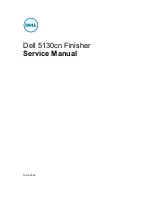
4. PAVING UP & DOWN GRADES
- When paving up a grade,
the rear of the paving rollers may need to be raised higher
(approximately 1/8” to 1/4”). Raise the back of the machine 1/8
of an inch by turning the leg crank 1/2 turn counter clockwise.
The augers may need to be adjusted lower. Adjust the augers
with the auger adjusting crank. These adjustments will counteract
the tendency of excess concrete from moving downhill toward the
paving rollers. When paving down a grade, the augers may need
to be raised higher to provide the proper amount of concrete to
the paving rollers. The rear of the paving rollers may not need to
be raised but be sure that there is close to total contact with the
deck or slab. When paving down hill, you want maximum surface
contact with the concrete but not allow any ridge or line of con-
crete to come off the rear of the paving rollers.
5. PAVING CURVES
- Given the known length or distance of the
inside and outside curve, mark an equal number of spaces on the
inner curve (1 to 2 feet in length). Count the number of spaces on
the inner curve and mark the same number of spaces on the outer
curve. The length of these spaces will vary with the length of the
outer curve section. To negotiate the inner curve, the operator will
at times place the machine direction control lever in the neutral
position allowing a longer amount of travel for the outer curve end
of the machine. Keep the front wheels of both the inner and outer
ends aligned with the marks placed on the rail or curb.
6. MACHINE ADVANCEMENT
- The advancement of the
machine at the end of each pass is based on the rate of concrete
being poured. The operator should pace the machine advance-
ment so that the physical placement of the concrete is no more
than 6 to 8 feet in front of the machine. Normal advancement of
the machine will vary from 3 to 6 inches (up to 12 inches) for each
carriage pass. This will insure that fresh concrete will move into
the paving rollers before dehydration of the concrete occurs. This
is particularly true in hot, windy weather. The decking and sub-
base material should also be kept wet in hot, windy weather to aid
in the slowing down of the drying process.
7. CARRIAGE TRAVEL SPEED
- At times it may be advanta-
geous to slow down the carriage travel speed. Slower carriage
travel will allow the paving rollers to have longer contact with the
surface. Slowing the carriage travel speed may be beneficial when
paving super plasticized concrete or latex modified concrete. The
carriage speed can be reduced by slowing down the engine or by
using the carriage speed control located on the operator’s con-
sole. The operating speed of the engine should run 3300-3500
RPM. At these speeds the carriage will travel approximately 85 to
90 feet per minute transversely across the machine.
8. BEFORE PAVING SKEWED DECKS
- Before paving skewed
decks it is essential that you determine all of the job specifications
and special details prior to setup of your 4836 Paver. Ask yourself
the following four questions: 1) What is the skew angle measured
perpendicular to centerline (90 degrees to centerline)? 2) What is
the distance between the screed rails, measured perpendicular
to centerline of the deck? 3) Is the deck super elevated? 4) Is the
deck crowned?
To determine the length of the machine set at the required skew
angle, use the following equation: “A” = the required skew angle.
“B” = the conversion factor (Ex: 1.04). “L”= the rail to rail length
as measured perpendicular to the roadway centerline in feet. “C”
= the extra machine length that is required due to skew. The total
machine length required = “B” x “L” + “C”.
SECTION 2
OPERATIONS
050362
Page 44
2.7 - Paving Operations, continued
Summary of Contents for BDF4836B
Page 5: ...050362 Page 5 Table of Contents continued ...
Page 14: ...050362 Page 14 Notes ...
Page 15: ...SECTION 1 SAFETY 050362 Page 15 SECTION 1 SAFETY ...
Page 21: ...SECTION 1 SAFETY 050362 Page 21 PAGE LEFT BLANK INTENTIONALLY ...
Page 22: ...Notes SECTION 1 SAFETY 050362 Page 22 ...
Page 23: ...SECTION 2 OPERATIONS 050362 Page 23 SECTION 2 OPERATIONS ...
Page 40: ...Power Crown Lever Nut A SECTION 2 OPERATIONS 050362 Page 40 2 6 Power Crown Option ...
Page 46: ...Skew Clamp Skew Cylinder SECTION 2 OPERATIONS 050362 Page 46 2 7 Paving Operations continued ...
Page 49: ...SECTION 2 OPERATIONS 050362 Page 49 PAGE LEFT BLANK INTENTIONALLY ...
Page 50: ...SECTION 2 OPERATIONS 050362 Page 50 Notes ...
Page 51: ...SECTION 3 SERVICE 050362 Page 51 SECTION 3 SERVICE ...































